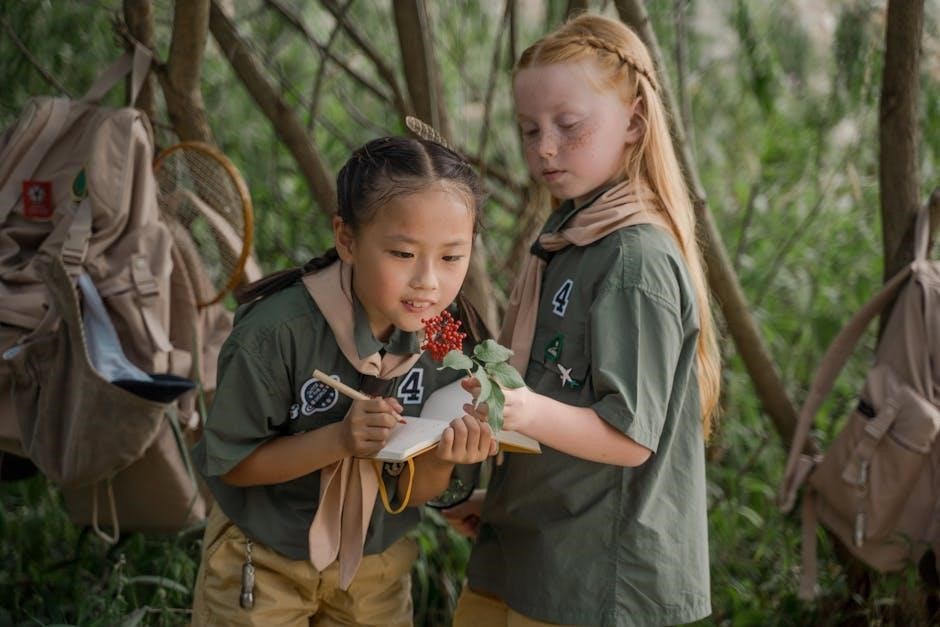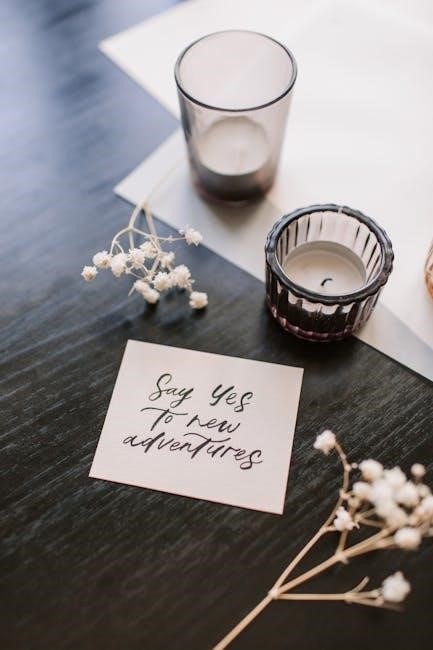Camp aesthetic, explored in Susan Sontag’s Notes on Camp, embodies exaggerated taste, artifice, and androgyny, blending irony with sincerity. It challenges norms, reflecting queer culture’s playful yet profound expression.
Definition and Overview of Camp
Camp, as explored in Susan Sontag’s Notes on Camp, is a cultural sensibility characterized by exaggerated taste, artifice, and a blend of irony and sincerity. It celebrates the dramatically exaggerated and the androgynous, often challenging traditional norms. Originating in queer subcultures, Camp reflects a playful yet profound way of engaging with aesthetics and identity. Sontag describes it as a “taste” that values the unnatural and the flamboyant, often subverting seriousness. Camp is not just a style but a way of interpreting the world, emphasizing humor, theatricality, and the beauty of the artificial. It thrives on contrasts, making the mundane extraordinary and the serious lighthearted. This sensibility has evolved over time, influencing fashion, art, and media, while remaining a powerful tool for social commentary and self-expression.
Historical Context of Camp Culture
Camp culture emerged in the mid-20th century, particularly within LGBTQ+ communities, as a response to societal marginalization. It served as a survival mechanism, allowing individuals to express themselves through exaggerated aesthetics and humor. Rooted in drag culture and theatricality, camp became a way to subvert norms and reclaim identity. Susan Sontag’s Notes on Camp highlights its evolution from an underground movement to a mainstream phenomenon. Camp’s early days were characterized by secrecy, with coded language and shared references creating a sense of community. Over time, it gained visibility, influencing fashion and media. The Stonewall riots marked a turning point, as camp became a tool for political expression. Today, camp continues to celebrate irony, artifice, and androgyny, bridging the gap between past struggles and contemporary culture. Its enduring appeal lies in its ability to challenge norms and foster creativity, making it a timeless cultural force.
The Role of Camp in Modern Pop Culture
Camp has become a defining feature of modern pop culture, influencing everything from fashion to film. It’s seen in bold, exaggerated styles and performances that celebrate artifice over authenticity. Camp’s irony and humor resonate with audiences seeking escapism and social commentary. Icons like Lady Gaga and RuPaul embody camp’s spirit, blending spectacle with subversion. TV shows such as RuPaul’s Drag Race and films like Moulin Rouge showcase camp’s theatricality. Camp challenges traditional norms, offering a platform for marginalized voices. Susan Sontag’s Notes on Camp remains a cornerstone, highlighting camp’s enduring relevance. Its ability to merge high art with kitsch makes it a powerful tool for cultural critique and creative expression. Camp’s presence in today’s media underscores its evolution from an underground movement to a mainstream phenomenon, proving its timeless appeal and cultural significance.


Key Characteristics of Camp
Camp is defined by exaggerated taste, artifice, and irony, often blending humor with sincerity. It celebrates the theatrical and challenges traditional norms through androgyny and playful subversion of seriousness.
Taste, Exaggeration, and Artifice
Camp aesthetic thrives on exaggerated taste, embracing the artificial and the theatrical. It celebrates the unnatural, often amplifying features to create a dramatic effect. Susan Sontag notes that Camp taste is not about beauty but about a heightened sense of artifice, where the exaggerated and the fake are revered. This sensibility often manifests in bold, over-the-top expressions, whether in fashion, performance, or art. Camp’s love for exaggeration allows it to challenge conventional norms, turning the mundane into the extraordinary. By elevating artifice to an art form, Camp creates a space where irony and sincerity coexist, blurring the lines between high and low culture. This blend of taste, exaggeration, and artifice defines Camp’s unique appeal and its ability to subvert traditional aesthetics.
The Androgynous Ideal in Camp
The androgynous ideal in Camp represents a blending of gender roles, celebrating ambiguity and fluidity. Susan Sontag highlights androgyny as a central Camp trope, where femininity and masculinity coexist in tension. Camp often idealizes figures that defy traditional gender norms, embracing a playful mix of traits typically associated with different sexes. This ideal challenges societal expectations, offering a liberating alternative to rigid gender definitions. In Camp, androgyny becomes a form of artistic expression, often exaggerated for dramatic effect. It reflects the Camp sensibility’s love for artifice and its rejection of naturalism, creating a space where gender becomes a performative act rather than a fixed identity. This androgynous ideal is both a political statement and a celebration of freedom, central to Camp’s subversive charm and enduring appeal.
Irony and Humor in Camp Expression
Camp expression thrives on irony and humor, often using exaggeration and artifice to highlight the absurdity of societal norms. Susan Sontag’s Notes on Camp emphasizes that Camp humor is not merely about laughter but about revealing the artificiality of cultural constructs. Irony in Camp serves as a tool to subvert seriousness, embracing the tension between sincerity and parody; Camp often celebrates the over-the-top and the kitsch, finding humor in the juxtaposition of high and low culture. This playful irreverence allows Camp to critique norms while maintaining a lighthearted, entertaining facade. Irony becomes a shield and a sword, protecting Camp from being taken too seriously while piercing through the pretensions of mainstream culture. Through humor, Camp creates a space for liberation and self-expression, where the ridiculous and the sublime coexist in perfect harmony.
The Relationship Between Camp and Innocence
Camp’s relationship with innocence is complex, as it often discloses innocence while simultaneously corrupting it. Susan Sontag’s Notes on Camp suggests that Camp vision transforms objects, revealing their inherent artificiality without altering their essence. Innocence, in this context, is not destroyed but recontextualized, often to expose its underlying naivety or sincerity. Camp thrives on the tension between purity and artifice, creating a space where irony and earnestness coexist. This dynamic allows Camp to critique societal norms while maintaining a playful, non-serious facade. The interplay between Camp and innocence highlights the fluidity of cultural values, offering a fresh perspective on what is considered genuine or contrived; Ultimately, Camp’s engagement with innocence serves as a mirror, reflecting the dualities of human expression and experience.

Major Theorists on Camp
Susan Sontag’s Notes on Camp is seminal, defining Camp as a sensibility marked by artifice and irony. Other theorists expand on its cultural and political dimensions, enriching its discourse.
Susan Sontag’s “Notes on Camp”
Susan Sontag’s Notes on Camp is a groundbreaking essay that defines Camp as a unique aesthetic sensibility. It emphasizes artifice, exaggeration, and the deliberate pursuit of beauty over naturalism. Sontag highlights Camp’s ability to transform the mundane into the extraordinary, often through irony and humor. She explores how Camp challenges traditional notions of taste and morality, offering a perspective that is both subversive and celebratory. The essay also delves into the historical and cultural contexts of Camp, tracing its evolution from underground subcultures to mainstream influence. Sontag’s work remains a cornerstone of Camp theory, providing a framework for understanding its significance in art, fashion, and identity. Her insights continue to shape contemporary discussions on Camp’s role in pop culture and queer expression.
Other Prominent Theorists and Their Contributions
Beyond Susan Sontag, other theorists have expanded on Camp’s cultural significance. Christopher Isherwood, for instance, explored Camp as a form of social satire and self-expression. His work highlights how Camp functions as a tool for marginalized groups to critique societal norms. Similarly, Andy Warhol’s pop art and films often embodied Camp sensibilities, blending kitsch with high art. Warhol’s embrace of Camp challenged traditional boundaries between art and popular culture. These thinkers, along with Sontag, have collectively shaped the understanding of Camp as a multifaceted phenomenon that intersects with queerness, irony, and artifice. Their contributions underscore Camp’s enduring relevance in cultural critique and creative expression, offering diverse perspectives on its evolution and impact.

Evolution of Camp Over Time

Camp has evolved from a hidden subculture to mainstream phenomena, influencing fashion, art, and media, while challenging traditional norms with its exaggerated, ironic style.
From Underground Subculture to Mainstream
Camp, once a hidden subculture, has transitioned into mainstream culture, gaining widespread recognition. Originating in LGBTQ+ communities, it expressed identity through exaggerated aesthetics and irony. Over time, its visibility grew, influenced by pop culture, fashion, and media. The 2019 Met Gala, themed “Camp: Notes on Fashion,” highlighted its impact on high fashion. Today, Camp’s playful, subversive style is celebrated globally, blending high art and kitsch. Its evolution reflects a shift from marginalization to mainstream acceptance, challenging traditional norms while embracing its roots in queer expression and artistic rebellion. This transformation underscores Camp’s adaptability and its enduring appeal as a cultural phenomenon.
How Camp Has Influenced Fashion and Art
Camp’s influence on fashion and art is profound, blending irony, exaggeration, and artifice. Designers like Versace and Jean Paul Gaultier have embraced Camp’s dramatic aesthetics, creating bold, gender-fluid collections. In art, figures like Andy Warhol and Keith Haring incorporated Camp sensibilities, celebrating vibrant, playful themes. The movement challenges traditional norms by redefining beauty and taste, often merging high art with kitsch. Camp’s impact is evident in its ability to democratize culture, making it accessible while maintaining its subversive edge. This fusion of creativity and rebellion continues to inspire contemporary designers and artists, ensuring Camp’s enduring relevance in both fashion and art.
- Camp’s exaggerated styles have redefined luxury and self-expression in fashion.
- Artists embracing Camp often explore themes of identity and cultural critique.
Modern Interpretations of Camp in Media
Modern media has embraced Camp aesthetics, blending irony, exaggeration, and artifice to create vibrant narratives. TV shows like RuPaul’s Drag Race and films such as Moulin Rouge! showcase Camp’s playful sensibility, celebrating self-expression and androgyny. Contemporary artists and designers continue to draw inspiration from Camp’s subversive charm, reimagining its principles for new audiences. This evolution reflects Camp’s ability to adapt while maintaining its core essence of challenging norms and embracing artifice as a form of authenticity. By merging high art with popular culture, modern interpretations ensure Camp remains a powerful force in media and beyond.
- Contemporary media often uses Camp to explore themes of identity and cultural critique.
- The blending of irony and sincerity in modern Camp creates a unique aesthetic experience.

Camp in Literature and Film
Camp’s exaggerated sensibility shines in literature and cinema, with classic examples like The Rocky Horror Picture Show and Oscar Wilde’s witty dialogue. These works celebrate artifice and irony, embodying Camp’s essence through bold characters and dramatic flair;
Classic Examples of Camp in Cinema
Camp cinema thrives on exaggerated aesthetics and ironic humor, with films like The Rocky Horror Picture Show embodying its spirit through flamboyant characters and audience participation.
- Mommie Dearest showcases over-the-top performances and melodrama, becoming a cult classic that celebrates artifice and theatricality.
- Valley of the Dolls blends glamour with campy storytelling, offering a dramatic yet humorous take on fame and identity.
- Showgirls is renowned for its hyperbolic dialogue and performances, turning it into a camp icon despite mixed reviews.
These films, while not always critically acclaimed, have gained cult followings for their bold, unapologetic approach to storytelling and performance, making them timeless examples of camp in cinema.
Literary Works That Embody Camp Sensibility
Literary works that embody camp sensibility often celebrate artifice, exaggeration, and a blend of irony with sincerity. Oscar Wilde’s The Picture of Dorian Gray is a quintessential example, as it explores themes of beauty, vanity, and the duality of innocence and corruption, all presented with a theatrical flair. Similarly, Bram Stoker’s Dracula features the androgynous and larger-than-life character of the vampire Count, whose presence is both menacing and campy due to his exaggerated mannerisms and aesthetic appeal. These works, as noted in Susan Sontag’s Notes on Camp, highlight how camp sensibility can transform even dark or serious themes into something playful and subversive, challenging traditional notions of taste and morality through their dramatic and stylized narratives.
Contemporary Camp in TV and Streaming
Contemporary camp in TV and streaming is vibrant, with shows like RuPaul’s Drag Race and Pose embodying the sensibility of exaggerated performance, humor, and androgyny. These programs celebrate camp’s core elements—artifice, irony, and a playful subversion of norms—while exploring queer identity and culture. In RuPaul’s Drag Race, the blend of wit, spectacle, and emotional depth exemplifies camp’s ability to merge sincerity with theatricality. Similarly, Pose uses camp aesthetics to highlight the resilience and creativity of LGBTQ+ communities, particularly in the ballroom scene. These shows demonstrate how camp continues to evolve, using modern platforms to challenge traditional notions of identity and entertainment, while staying true to its roots in irony, exaggeration, and a celebration of the unconventional.

Camp and Identity
Camp serves as a powerful tool for identity expression, blending humor, irony, and artifice to challenge traditional norms and celebrate queer culture’s resilience and creativity.
Camp as a Tool for Social Commentary
Camp often serves as a lens to critique societal norms, using irony and exaggerated aesthetics to highlight cultural hypocrisies. By embracing artifice and humor, camp challenges conventional values, offering a subversive yet playful commentary on identity, power, and morality. It subverts seriousness, making it a powerful tool for questioning authority and norms. Through its exaggerated expressions, camp reveals the constructed nature of reality, often exposing the artificiality of societal expectations. This sensibility allows camp to address complex issues like gender, class, and sexuality in a way that is both accessible and provocative. Camp’s ability to blend irony with sincerity makes it a unique and effective medium for social critique, enabling it to provoke thought while entertaining. Its role in highlighting the absurd and the artificial underscores its value as a cultural and political commentary tool.
The Intersection of Camp and Queer Culture
Camp and queer culture are deeply intertwined, with camp serving as a powerful form of self-expression and empowerment for LGBTQ+ communities. By embracing artifice, irony, and exaggeration, camp allows queer individuals to challenge traditional norms and reclaim their identities. It provides a space for playful subversion of societal expectations, celebrating androgyny and nonconformity. Camp aesthetics often feature in queer art, fashion, and performance, becoming a language of resistance and resilience. This intersection highlights how camp not only reflects queer sensibilities but also amplifies them, creating a shared cultural vocabulary. Through camp, queer culture asserts its presence, blending humor with defiance to challenge heteronormativity. The camp sensibility, as explored in Notes on Camp, continues to be a vital tool for queer expression and solidarity, fostering a sense of community and pride.
How Camp Challenges Traditional Norms
Camp challenges traditional norms by subverting conventional aesthetics and behaviors, often through exaggerated irony and artifice. It mocks seriousness and embraces the absurd, turning the mundane into the extraordinary. By celebrating the artificial and the theatrical, camp undermines the authority of rigid societal norms. This sensibility thrives on contradiction, blending high and low culture to create a unique form of resistance. Camp also challenges gender norms through its embrace of androgyny and nonconformity, rejecting binary definitions of identity. Its playful subversion of expectations fosters inclusivity and diversity, offering a counterpoint to mainstream values. As explored in Notes on Camp, this rebellious spirit continues to inspire creative and cultural expressions that defy tradition, making camp a enduring force for change in a rapidly evolving world.

Practical Applications of Camp
- Camp influences fashion, encouraging bold, exaggerated designs that celebrate artifice and irony.
- It enhances performance and theater, fostering dramatic, over-the-top expressions that captivate audiences.
- Camp inspires marketing strategies, using humor and spectacle to create memorable brand experiences.
Camp in Fashion Design
Camp in fashion design celebrates exaggerated aesthetics, blending irony with sincerity. It often features bold, unconventional styles that challenge traditional notions of taste and beauty. Designers like Jean Paul Gaultier and Alexander McQueen have embraced camp, creating garments that are theatrical and provocative. The use of androgyny, vibrant colors, and playful patterns reflects camp’s essence. Fashion brands leverage camp to make statements, combining humor with high artistry. This approach not only pushes boundaries but also resonates with audiences seeking self-expression and individuality. Camp in fashion is more than a trend—it’s a cultural commentary, redefining norms and inspiring creativity. By embracing artifice and drama, camp continues to influence contemporary fashion, making it a timeless and transformative force in the industry.
Using Camp in Performance and Theater
Camp in performance and theater thrives on exaggerated expressions, irony, and playful subversion of norms. It often involves dramatic flair, where actors embrace androgyny and artifice to create memorable characters. Theatrical productions like drag shows or cabaret performances exemplify camp, blending humor with emotional depth. Performers use camp to challenge societal expectations, creating a dialogue between the audience and the performance. This sensibility allows for bold storytelling and experimentation, making camp a powerful tool for social commentary. By celebrating the artificial and the dramatic, camp in theater fosters a unique connection with audiences, offering both entertainment and reflection. Its ability to merge irony with sincerity ensures its relevance in contemporary performance art, continuing to inspire new interpretations of identity and culture.
Camp as a Marketing and Branding Strategy
Camp’s blend of irony, exaggeration, and artifice makes it a compelling marketing tool. Brands leverage camp’s playful subversion to stand out, creating memorable campaigns that resonate emotionally. By embracing the absurd and the theatrical, companies can forge a unique identity, appealing to audiences seeking authenticity and humor. Camp’s ability to challenge norms allows brands to position themselves as bold and innovative. Social media platforms amplify camp’s impact, enabling viral engagement through shareable, iconic content. However, camp’s success in marketing hinges on balance—too much irony can alienate, while just the right touch fosters connection. Brands like Meta and fashion houses have effectively harnessed camp, proving its potency in capturing attention and loyalty in a crowded marketplace. Thus, camp remains a dynamic strategy for brands aiming to leave a lasting impression.

Camp’s timeless appeal lies in its ability to blend irony with sincerity, offering a unique lens on culture. Its enduring relevance continues to inspire and challenge aesthetic norms.
The Timeless Appeal of Camp
Camp’s enduring allure stems from its unique blend of exaggerated aesthetics and ironic humor, creating a sensibility that transcends time. By celebrating artifice and challenging traditional norms, camp offers a lens through which culture can be both critiqued and revered. Its ability to transform the mundane into the extraordinary, often with a wink of irreverence, ensures its relevance across generations. Whether in fashion, film, or performance, camp’s vibrant sensibility continues to captivate audiences, inviting them to embrace both the serious and the absurd. This duality—where humor meets profundity—underscores camp’s timeless appeal, making it a enduring force in shaping artistic expression and cultural dialogue.
Future of Camp in a Changing World
Camp’s future lies in its adaptability to evolving cultural and technological landscapes. As the world becomes more interconnected, camp’s exaggerated sensibility and ironic humor will continue to resonate, offering a universal language of self-expression. Digital platforms and social media have already amplified camp’s visibility, allowing it to transcend traditional boundaries. Younger generations, influenced by camp’s playful subversion of norms, are reinterpreting its aesthetics in fresh, innovative ways. Camp’s ability to blend nostalgia with modernity ensures its relevance, even as societal values shift. By embracing diversity and fostering inclusivity, camp will remain a powerful tool for challenging conventions and celebrating individuality. Its enduring appeal guarantees that camp will continue to inspire artists, designers, and performers, ensuring its legacy in an ever-changing world.
Final Thoughts on the Significance of Camp
Camp, as explored in Susan Sontag’s Notes on Camp, remains a profound cultural phenomenon, blending artifice, irony, and exaggeration to challenge traditional norms. Its significance lies in its ability to subvert seriousness, offering a unique lens through which to view identity, aesthetics, and societal structures. Camp’s playful yet profound sensibility has transcended its origins, influencing fashion, art, and media. It serves as a tool for social commentary, particularly within queer culture, where it fosters resilience and creativity. Camp’s enduring relevance underscores its capacity to evolve, ensuring its continued impact in a changing world. By celebrating the artificial and the exaggerated, camp not only reflects but also shapes cultural discourse, leaving an indelible mark on modern expression and identity.